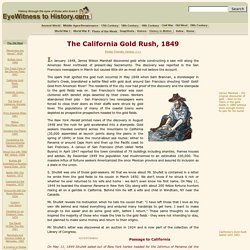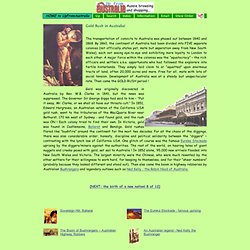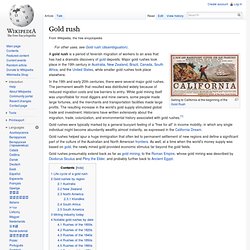

The California Gold Rush, 1849. The California Gold Rush, 1849 In January 1848, James Wilson Marshall discovered gold while constructing a saw mill along the American River northeast of present-day Sacramento.

The discovery was reported in the San Francisco newspapers in March but caused little stir as most did not believe the account. The spark that ignited the gold rush occurred in May 1848 when Sam Brannan, a storekeeper in Sutter's Creek, brandished a bottle filled with gold dust around San Francisco shouting 'Gold! How it started? Sutter's Mill(Source: Library of Congress) On January 4, 1848, James Marshall picked up a piece of metal at the mill that looked like gold.

He took the metal to Sutter. They tested it and confirmed that it was gold. Sutter was afraid that the discovery of gold would take his workers away from the fields. He was also concerned that gold would bring prospectors onto his land. But word got out! When did the gold rush start in Australia. Gold Rush Festival - Gympie Goldrush. Gold! Gold rush – Flash interactive.
Australian gold rushes. An Australian gold diggings circa 1855 After the California gold rush began in 1848, causing many people to leave Australia for California to look for gold there, the New South Wales government rethought its position, and sought approval from the Colonial Office in England to allow the exploitation of the mineral resources and also offered rewards for the finding of payable gold.[2] The first gold rush in Australia began in May 1851 after prospector Edward Hargraves claimed to have discovered payable gold near Bathurst, at a site he called Ophir.[3] Hargraves had been to the Californian goldfields and had learned new gold prospecting techniques such as panning and cradling.

Gold Rush in Australia! The transportation of convicts to Australia was phased out between 1840 and 1868.

By 1860, the continent of Australia had been divided into FIVE separate colonies (not officially states yet, mate but seperation away from New South Wales), each not seeing eye-to-eye and exhibiting more loyalty to London to each other. A major force within the colonies was the “squatocracy” – the rich officers and settlers a.k.a. opportunists who had followed the explorers into fertile hinterlands. They simply laid claim to or “squatted” upon enormous tracts of land, often 20,000 acres and more. Free for all, mate with lots of social tension. Development of Australia was at a steady but unspectacular rate.
Australian Gold Rush. In fact they only got worse.

A powerfully disruptive hysteria seemed to grip the State along with the rest of the country. Farmhands simply left their employers with harvests they could no longer reap and thousands of workers fled Melbourne leaving empty industries in their wake. Wages tripled due to scarce labour. To raise money, many property owners put their houses on the market. But as there was no one interested in buying, house prices collapsed. Luckily however, this was not to last.
Australian gold rush. Gold rush. Sailing to California at the beginning of the Gold Rush A gold rush is a period of feverish migration of workers to an area that has had a dramatic discovery of gold deposits.

Major gold rushes took place in the 19th century in Australia, New Zealand, Brazil, Canada, South Africa, and the United States, while smaller gold rushes took place elsewhere. In the 19th and early 20th centuries, there were several major gold rushes. The permanent wealth that resulted was distributed widely because of reduced migration costs and low barriers to entry. While gold mining itself was unprofitable for most diggers and mine owners, some people made large fortunes, and the merchants and transportation facilities made large profits.
Gold rushes were typically marked by a general buoyant feeling of a "free for all" in income mobility, in which any single individual might become abundantly wealthy almost instantly, as expressed in the California Dream. The Australian gold rush. JCF Johnson, A Game of Euchre, col. wood engraving, Australasian Sketcher Supplement [Melbourne], 25 December, 1876.

Image courtesy of the : nla.pic-an8927787. The gold rushes of the nineteenth century and the lives of those who worked the goldfields - known as '' - are etched into our national . There is no doubt that the gold rushes had a huge effect on the Australian economy and our development as a nation. It is also true to say that those heady times had a profound impact on the national psyche. The camaraderie and '' that developed between diggers on the goldfields is still integral to how we - and others - perceive ourselves as Australians. Indeed, mateship and defiance of authority have been central to the way our history has been told. Even today, nothing evokes more widespread national pride than groups of irreverent Aussie 'blokes' beating the English at cricket, or any other sport for that matter!
GoldRush.